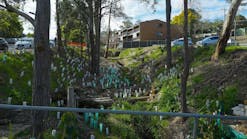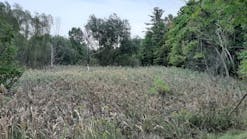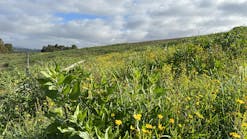To control erosion in areas of heavy water flows, riprap is often prescribed; however, purchasing, transporting, and setting such large rocks can be quite costly. In addition, depending upon the site, large boulders might not be the most attractive option. Advancements in erosion control blankets, mattresses, and turf reinforcement mats allow them to stand up to large water influxes, and they support vegetation, which makes the area treated look more natural.
Blanketing the Shore
Coastline erosion is a serious and continuing problem, especially if one’s house is near the shore. Hamilton Beach on Chebeague Island, ME, was originally surveyed and developed in 1895. When the area was surveyed in 2007 after a severe April storm, it was discovered that 38 to 46 feet of shoreline had been lost since the initial survey; some structures were as little as 14 feet from the top of the eroding embankment.
Large rocks were placed at the bottom of the slope to break up the waves. Marine mattresses were stacked behind the rocks, then covered with geotextile and fill.
behind the rocks, then covered with geotextile and fill.
To combat the problem, six shorefront property owners banded together as the Hamilton Beach Owners Group, and, with the town of Chebeague, which also owns the public access to the beach, they investigated ways to stabilize the approximately 740 linear feet of shore frontage.
Freeport, ME’s Baker Design Consultants was contracted to create a solution. “We took the job after the storm of April 2007,” says owner Barney Baker, P.E. “The site includes seven total properties-three private lots on either side of the town’s right of way. We had a surveyor go out and map the coastline, so we could make our design.” More than coastline was at stake; these properties were historic treasures. “This area has been a holiday and retirement island for well over 100 years,” he notes. “People would come by boat or train from New York, Boston, the District of Columbia. Most of these homeowners are second- or third-generation islanders, but based in other states.”
Unfortunately, more erosion occurred as the project stalled. “It took us four years to get through the design and permitting,” Baker explains. “We needed local, state, and federal permits, plus approval from the Maine Department of Environmental Protection and the US Army Corps of Engineers. However, a similar project could move faster today, as we have this successful project as an example of what can be done.” Bids were accepted in September 2011, and the project was completed in May 2012 by Anderson Landscaping Inc. of North Yarmouth.
When Baker’s first suggestion, shoring up the area with hard armor or rock, was rejected by Maine, he proposed installing mattresses filled with stones, which would be vegetated in the final step. Baker turned to Poseyville, IN’s Tensar-North American Green for its Triton Marine Mattress System.
Joe Koziell, Tensar-North American Green Northeast region manager for erosion control, explains the mattresses’ construction. “Our mattresses are made from polypropylene, the same product used in our Triax geogrids. They’re corrosion-resistant, so seawater has zero impact on them. Other manufacturers make their mattresses out of PVC-coated steel wire. When filling such mattresses with rocks, some PVC coating can be nicked off, exposing the steel beneath to seawater. Before long, those exposed areas can rust. Barney had experience with our company, including prior conversations with the Tensar tech group about applications for the Triton Marine Mattresses, and it was the perfect solution.”
Baker outlines the steps taken in saving the slope. “First, Anderson Landscaping excavated and shaped the slope, then laid geotextile, before placing heavy stone to form the toe of the embankment. We wanted something very massive to define the slope. This part of Maine has a lot of rock outcrops, as the area was heavily glaciated during the Ice Age. The material deposited at the edge of the glacier when it retreated is mostly fine clays, mixed with boulders and sand-highly erodable soils. This glacial till deposit, referenced by Maine’s geological survey, is called the Presumpscot Formation, so-called because the glacier stopped near the Presumpscot River.
“Wave action can erode the bottom of the slope,” Baker goes on, “so those large stones were laid in a short line or barrier to break up the energy of the waves. The boulders protect the rest of the system. Storm surges will attack a slope up to a certain elevation; here, the high-tide elevation was 5 feet, and the storm surge elevation, 12 feet. The toe stones protect the slope from waves that occur during the normal tide cycle, up to 7 feet. Unfortunately, regulatory agencies wouldn’t let us go to the storm surge elevation.” The mattress units protect higher sections of the slope from wave action up to the FEMA base flood elevation (MHW plus 8 feet) that is predicted to occur in a 100-year storm event.
Once the large stones were in place, Tensar Triton Marine Mattresses were installed. “The stones placed inside the mattresses are considerably smaller than what was once used to armor slopes,” Koziell says. “For example, using riprap, you’d use 36- to 46-inch or larger rock.
In the mattress, we can get away with 3- to 5-inch stones.” The mattresses were filled onsite. “The first idea was to fill the mattresses at a quarry, then barge them in. However, Anderson Landscaping decided they would barge the stone to the island and fill the mattresses at the upland laydown area.”
“The Tensar mattresses arrive flattened, and you open them up,” Baker explains. “You put them in a special jig or box so you can load the stones. Anderson Landscaping did a great job, building a box form and filling the mattresses. We needed a total of 94 mattresses of various lengths. Most were 1.5 feet thick by 4 feet wide, in 10- and 20-foot lengths. The mattresses were then tied or anchored because the slope was unstable. Those anchors were sunk 10 feet. It was almost like we were “˜hanging’ the mattresses on the slope.”
The regulatory agencies wanted a vegetated solution. Once the mattresses were laid, they were filled with some topsoil and seeded. “We specified an erosion control mix, a blend of different quick-growing grasses like winter rye,” Baker says. “We also added plantings. Rosa ragusa, a salt-tolerant low-lying bush, was placed between the mattresses.”
Even before the plantings took hold, the Atlantic Ocean threw up some “camouflage.” “We had a meeting with Anderson Landscaping and the homeowners in April 2012, and they were very happy. The vegetation was coming in. Also, seaweed washes in and covers the mattresses-you can’t see the baskets. The project looks very good. Another selling point: If for whatever reason a mattress needs repair, it’s easy to replace a damaged mattress and tie it in with the others. This installation weathered two major storms during winter 2012, and the mattresses survived with no problem whatsoever,” Koziell adds. This project was Tensar-North American Green’s second project in Maine. Several projects are in work in Rhode Island and New Jersey, as well as other coastal projects down the eastern seaboard.
Baker Design Consultants designs waterfront structures, piers, bulkheads, revetments, and waterfront access projects. “My background is in structures and bridges; my degree is in civil engineering and soil mechanics. Our firm specializes in slope stabilization, which is about 20% of our work,” says Baker.
He is especially proud of the Hamilton Beach project. “If you add it all up, with all the indentations, Maine has more coastline-4,500 miles-than the rest of the eastern seaboard. The state has very strict rules on visual and environmental impact regarding its coastline. We chose a solution that, when finished, has a green look, which preserves the visual impact of the pristine Maine shore.” Not only did Baker have to concern himself with the appearance of the project, but he also had to consider wildlife needs. “This type of work is most suited to winter construction, as we’re limited by times of migration for birds or fish. The coastline ecosystem is quite fragile, so that leaves you the winter to get the work done. One advantage: The colder it is, the less runoff the contractor has to deal with.”
Making Stormwater Channels More Natural
In the 1970s, the city of South Bend, IN, created a Model Cities plan to separate its storm and sanitary sewers. The implementation of the plan is ongoing; a recent installation was designed and overseen by The Troyer Group of Mishawaka, IN.
“We designed, and I was the project manager, of the Diamond Avenue project, which is part of 2009’s Studebaker Corridor feasibility study,” says Christopher L. Waidner, P.E. “Diamond Avenue was designed as a three-phase project. The first phase, the outfall, was completed in 2011; the second phase was finished in 2012; the third phase should be done at the end of this year.”
Diamond Avenue, a minor collector street, gets an abundance of truck traffic, and a trunk storm sewer was installed near there. “Our project takes this separated stormwater from where it connects back into the CSO [combined sewer overflow] and provides a direct outlet to the St. Joseph River,” Waidner explains. “A total of 4,250 feet (0.8 mile) of 90-inch-diameter gravity sewer pipe will be laid. From there, the water daylights into an 800-foot channel before being distributed into the riverbed.”
As some of this water is then channeled aboveground, the land had to be sculpted and planted, to avoid erosion. The Troyer Group used Recyclex TRM-V permanent turf starter from Arlington, TX’s American Excelsior as part of the channel’s lining matrix.
“There’s a roughly 20-foot steep river bank in the location of the outfall-which lies between the Angela St. bridge and an old railroad trestle bridge-with Riverside Road and Trail in close proximity. Along with moving the stormwater, our goal was to also make this installation pleasing to the eye. We put in a small retention basin, a series of drops, and a waterfall, making it look like a natural stream,” Waidner comments.
Recyclex TRM-V was used with a geocell material, which, even before plantings grew in, provided a natural green-looking surface. “We liked the strength and recycled properties of the Recyclex product. We worked with the manufacturers of the liner, the turf reinforcement mat, the geotextile, and the cellular confinement system in the development of an engineered lining matrix to armor the streambank.
“We liked that we could plant the banks, yet it would hold up to storms and lots of water,” he goes on. “The channel is designed to handle a peak discharge flow of 394 cubic feet per second. The geocell was nailed down, and we used 1,860 square yards of Recylex, which was seeded after installation. First, we planted plugs of Prairie Cordgrass at outlet structures, then seeded the rest with a mixture of native prairie and stormwater seed mix.”
This portion of the project moved along with few hitches. “Rieth-Riley was the job’s general contractor, and Acorn Landscaping and Excavating was the subcontractor for this portion of work. There were interpretation issues during installation of the cellular confinement system around pipe outlets, but no issues with the rest of the system,” Waidner concludes.
Saving Valuable Farm Soil
From a farmer’s point of view, erosion isn’t just “a mess,” it means losing real estate, losing the very item that makes his agricultural products possible. Ray Levan’s farm, located in Catawissa, PA, has been in his family for a century. However, when a dragstrip went in next to his property, its runoff caused an erosion problem.
“The dragstrip is slightly above us,” Levan says. “We worked with the Soil Conservation Service over the years to contour the fields; the whole farm has been terraced. We made sure to put one terrace or berm near the property line, trying to keep the water from washing in from the dragstrip. Of course, then we have to drain that water to a creek area, which means diverting it across our land; that’s where we put the conservation area. However, the water was eroding ditches out all the time. Even though we had good sod in that area, the water came down at such a fierce pace that it eventually made ditches 1 to 2 feet deep.”
“We were contacted by the USDA NRCS [Natural Resources Conservation Service] Bloomsburg, PA, office, to see if we’d be interested in a demonstration project, installing TRMs in a farm swale that normally would have required rock riprap,” explains John Ravert, CPESC, NICET, director of technical services for Bernville, PA’s East Coast Erosion Blankets LLC. “We were eager to help, and installed various TRMs in a 1,000-foot-long swale.”
“Levan voluntarily developed a conservation plan to address resource concerns on his farm,” explains NRCS design engineering technician Mark Groshek. “The farm definitely had an erosion problem from the neighboring dragstrip and other nearby agricultural areas. The USDA had put in a grass waterway channel years ago, but it failed, resulting in a gully through Levan’s farm. The watershed is 53 acres, and the runoff from a 10-year design storm is 110 cubic feet per second. Something had to be done, and it was, in spring 2012.”
In the past, rock riprap would have been used to stop erosion. In fact, when Levan uncovered large rocks on his farm, he would haul them to that area. Using East Coast Erosion Blankets was deemed a better solution in many ways.
“Economically, this blanket was much cheaper than rock-about half the cost,” Groshek says. “Not only would there be costs for hauling the rock in there, but also we would have to excavate channels for the rock. I’ve just started using this permanent turf reinforcement. A high velocity of water can go through it, but it protects the area from erosion.
“A TRM needs much less excavation than does a rock-lined channel,” he continues. “The digging needed was to shape a bowl-shaped or parabolic swale, and we did need 6 inches of topsoil in the channel to stimulate vegetation. Before using TRMs, channels would need to be much wider and shallower. For example, on this waterway our software calculated that a grass channel would need to be 60 feet wide by 0.8 foot deep without a protective lining, which is not practical. The TRM allowed us to reduce the width; we ended up going with a 22-foot-wide by 1.3-foot-deep channel. Actually, the channel’s depth varies from 0.9 to 1.3 feet; If we had gone with a riprap solution, the channel would’ve been 14 feet wide, at the same depth, but rock is very costly. You have to dig out 2.5 feet of the soil to make room for the rocks.”
The area was seeded before the TRMs were laid down.
“We put lime and fertilizer down on the soil, then seeded, before putting the blankets down. We used lots of staples to hold the netting down. Some parts of this blanket are biodegradable. Grass grows up through the permanent web and that holds everything together better. Once established, this should be mowed once or twice a year, to control weeds,” Groshek says.
Results were quickly made evident. “It was raining when we put the TRMs down, then water flowed in,” Groshek says. “One week after installation, the farm received over 2 inches of rain in two days. On May 29, 4 inches of rain fell in 45 minutes, and the channel worked well. We wanted to test the site, push the limits of it. At first, I was hesitant, as companies make velocity claims, but no problems thus far. Installation wasn’t difficult.
“Our crew consisted of myself, workers from East Coast Erosion Blankets, and Levan and his sons. In most cases, the farmer hires the contractor, buys the materials, and, if he qualifies, receives an incentive payment from the NRCS Environmental Quality Incentives Program, which helps offset the cost. For this demonstration project, East Coast Erosion Blankets pitched in with some of the cost.
“Now that we know this is a good solution, we installed a handful of blankets around the area during summer 2012,” he continues. “To design such channels, we got new software, which evaluates the stress on the soil, in addition to the vegetation. Aesthetically, it’s better to see grass than riprap, and a reinforced grass channel is easier for farm equipment to work around.”
Can TRMs be used in areas with extended flows of spring water? “Unfortunately, no,” says Groshek. “The water stays in the channel too long; it stays wet, and grass won’t grow. Blankets are not a “˜catchall’ product. In such cases, one can sometimes install subsurface drainage and surface inlets to control spring flow.”
Levan’s equipment must be able to traverse the entire acreage of his busy farm. “We’re growing 250 acres of field corn, a couple acres of oats, 100 acres of wheat, 120 acres of soybeans, 88 acres of snap beans, 20 acres of black oil sunflower, and a couple acres of canola. Since we have about 30 head of beef cattle, we also plant 25 acres of hay for them. Our two broiler houses contain 50,000 chickens, and we raise 10 to 20 hogs for family use and immediate neighbors. As for moving around, you can’t really go over that ditch perpendicularly with farm equipment; you will drag. However, you can go crossways over it. Thankfully, I don’t have to go over it a lot when I’m planting or reaping.
“So far, it looks pretty nice,” Levan goes on. “They put in two different types of blankets-UV netting woven with straw at the bottom end of the waterway, where the water would’ve been the fiercest. When it becomes damp, it just hugs the ground. On the upper half, where the water flow is not as fierce, there’s a plastic blanket. But when the grass started to grow through the plastic one, the grass pushed it up. At the bottom end, grass grew through the straw-filled blanket and didn’t push it at all.
“However, later in the year, the plastic blanket was back down on the ground, with grass coming through it. Eventually, probably I’ll not be able to see the blankets at all.”









